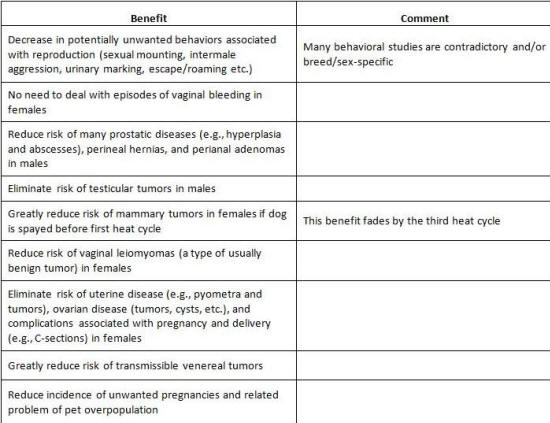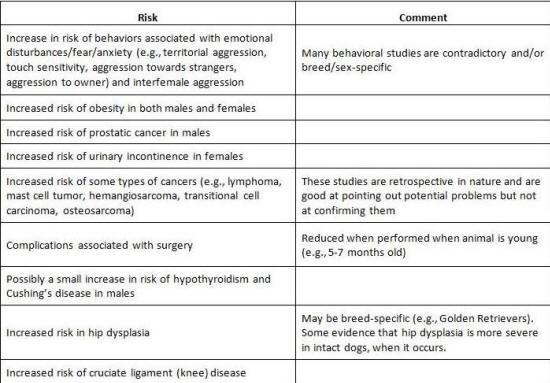|
 If you have an animal that has not been spayed or
neutered, you should consider the pros and cons, which includes
health benefits to the animal. If you have an animal that has not been spayed or
neutered, you should consider the pros and cons, which includes
health benefits to the animal.
By the numbers
Cats have larger litters and they reproduce more often than dogs.
Statistically, over a seven year period, one female cat and her
offspring can produce 370,000 kittens based on every generation
having multiple
females with a litter and every female mating again, and again.
In contrast, a female dog and her following generations of females
over a six year period could produce 67,000 puppies.
Unaltered, unpopular behaviors
Unaltered male dogs and cats display undesirable pet behaviors. And
in both species, males become more aggressive toward other males and
injuries may occur.

Cats
Unaltered male cats and female cats in heat spend a great deal of
time serenading. They are seeking a partner and may spend an hour or
two calling and caterwauling, which can become disruptive in our
lives.
In addition male cats have the unseemly habit of “marking their
territory” through urination. The act of “spraying” can result in
smelly destructive damages to homes.
When considering the pros and cons of whether or not to have a cat
spayed or neutered, the cons are few, but there are some important
health benefits to spaying.
Most veterinarians recommend that kittens be spayed or neutered at
some point between the age of eight weeks and six months.
Of great importance, breast cancer is very aggressive in female
cats. Spaying before the first heat cycle almost completely
eliminates the risk of mammary or breast cancer.
However, the balance is between risks. Surgery and anesthesia
becomes safer for older animals.
Spaying also eliminates the chances of Pyometra or uterine cancer in
females, and for males, neutering reduces the chance of testicular
cancer.
Another benefit to both male and female cats is that it lowers
chances at acquiring Feline AIDS and Leukemia. Biting, scratching
and other aggressions during breeding or fights increases
transmission of diseases.
Dogs
When considering whether or not to have your canine friend spayed or
neutered, some factors vary from cats and need to be considered for
your dog's best health and well-being.

BENEFITS -
click to enlarge

RISKS - click to enlarge Spaying
or neutering can reduce the instances of particular cancers. Same as
for cats, the cases of mammary cancer and pyometra are reduced in
female dogs, and testicular cancer and prostate cancer are reduced
in males.
At the same time, other types of cancer risks can
increase after the animals are “fixed.”
Avoiding Pyometra is a big argument for spaying female dogs.
Pyometra is an infection of the uterine tract. The dog can become
very ill from this infection and emergency surgery is generally
required in order for the dog to return to good health. The
advantage to spaying a young dog is that it is healthy and at the
appropriate age to recover quickly from the surgery.
[to top of second column] |

Other concerns after spay or neuter, dogs on the
average experience a 30 percent reduction in their baseline
metabolism - Firstvet.com –
Neutering female dogs – advantages and disadvantages.
After spaying your dog may also experience a change in coat
condition. Hair or fur may become fuzzier, richer, or rougher after
surgery.
An article written on the Dog Blog opposes a popular belief that
spaying or neutering will calm down an over active or aggressive
dog.
Should I Neuter My Dog? The Pros and Cons of Neutering - “Owners
(who) want to calm down unruly or aggressive males, castration does
not do this; training does! In fact, when neutering male dogs,
testosterone-mediated aggression can turn into fear-based
aggression; testosterone actually increases a dog’s confidence
levels making them feel calmer in certain situations.”
The article also discusses findings of a study published in July of
2020 regarding the appropriate age for specific breeds. The popular
belief is that all dogs should be spayed or neutered at a young age.
Researchers from the University of California, School of Veterinary
Medicine found that within certain breeds spaying or neutering too
young can lead to serious issues with bone health. As an example,
the study showed that Border Collies should be spayed or neutered
after they turn one year old. For Bulldogs, one should wait until
the dog is “physically mature” and beyond two years old. The same is
true with cocker spaniels.
The study looked at all sides of the spay/neuter process and its
impact on dogs. The end result gives readers and veterinarians much
to think about when considering the process. The final take away
though was that the pros do outweigh the cons in that the life span
of dogs will be longer when spayed or neutered.

A fixed pet that no longer has an aggressive sex drive is calmer,
healthier and usually more affectionate toward its humans.
One caution for pets post-spaying or neutering is to watch for
weight gain. Spaying and neutering causes the metabolism to drop. If
your cat is getting chubby make dietary adjustments before it gets
out of hand.
In summary, there are few potential negatives to having your cat
spayed or neutered. On the other hand there are more factors to
consider for your dog - breed and timing.
So, before you make your decision, do your homework. Consider breed
choice, the healthiest or best time of life to have the procedure
done, as well as what it is you want for your pet and your
household.
If you want to further educate yourself on how to keep your pet
healthy, PetMD.com is a good online resource.
For major decisions, the best resource for any pet owner of course
is your pet's veterinarian.
Sources
Canine research
Assisting Decision-Making on Age of Neutering for 35 Breeds of Dogs:
Associated Joint Disorders, Cancers, and Urinary Incontinence
Front. Vet. Sci., 07 July 2020 |
https://doi.org/10.3389/fvets.2020.00388
PetMD.com
https://www.petmd.com/
Firstvet.com
https://firstvet.com/uk
The Dog Blog
https://the-dog-blog.org/
|